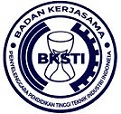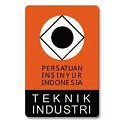Penerapan Metode PDCA dan Paired T-Test Untuk Meningkatkan Kepuasan Karyawan Pada CV Delimas
Abstract
CV Delimas adalah salah satu perusahaan pada bidang percetakan tertua di kota Balikpapan yang berdiri sekitar tahun 1970 yang terletak di Manggar, Balikpapan Timur. Pada proses produksi box packaging di CV Delimas dilakukan pada area kerja yang kurang mendukung kepuasan karyawan nya saat bekerja karena penempatan peralatan dan material berada di tempat yang tidak pada tempat dan fungsinya, sehingga menyebabkan lantai produksi menjadi kotor. Pendekatan dalam manajemen industri yang dapat digunakan untuk meningkatkan kualitas dan efisiensi proses terhadap permasalahan di atas yaitu PDCA (Plan, Do, Check, Action) dan 5S (Seiri, Seiton, Seiso, Seiketsu, Shitsuke). Penelitian ini bertujuan untuk melakukan analisis dan penerapan metode PDCA serta 5S untuk membentuk standarisasi dan menjaga kebersihan lingkungan kerja, sehingga mampu meningkatkan kepuasan karyawan dalam bekerja. Hasil yang diperoleh pada kuesioner setelah penerapan mendapatkan nilai kepuasan karyawan hingga 67% dan nilai checklist 5S mencapai 75% dengan skala baik. Pada pengujian hipotesis paired t-test mendapatkan t value > t tabel yakni sebesar 14,65 > 2,26. Berarti dalam penelitian terdapat perbedaan dan pengaruh positif terhadap kepuasan karyawan. Rekomendasi yang diberikan dengan membuat display, jadwal piket kebersihan dan jadwal pemeriksaan berkala diharapkan mampu untuk meningkatkan kepuasan karyawan.
Full Text:
PDFReferences
S. Ghosh, “A PDCA based approach to evaluate green supply chain management performance under fuzzy environment,” Int. J. Manag. Sci. Eng. Manag., vol. 18, no. 1, pp. 1–15, 2023, doi: 10.1080/17509653.2022.2027292.
F. Shi, “One-step hydrothermal synthesis of 2,5-PDCA-containing MgAl-LDHs three-layer composite coating with high corrosion resistance on AZ31,” J. Magnes. Alloy., vol. 11, no. 7, pp. 2541–2557, 2023, doi: 10.1016/j.jma.2022.05.017.
A. Chiarini, “Integrating ISO 9001 and Industry 4.0. An implementation guideline and PDCA model for manufacturing sector,” Total Qual. Manag. Bus. Excell., vol. 34, no. 13, pp. 1629–1654, 2023, doi: 10.1080/14783363.2023.2192916.
Y. Bonardo, “Design of Document Control System for Incoming and Outgoing Spare Parts in The Co-generation System (CGS) Area Using Kaizen and The PDCA (plan, do, check, and act) Method,” E3S Web of Conferences, vol. 426. 2023. doi: 10.1051/e3sconf/202342601069.
D. Mujica-Suarez, “Successful implementation of the SMED and TPM tools under the PDCA methodology to increase order fulfillment in a company in the Plastic Sector,” Proceedings of the LACCEI international Multi-conference for Engineering, Education and Technology, vol. 2023. 2023. [Online]. Available: https://api.elsevier.com/content/abstract/scopus_id/85172373394
Y. Huang, “A FOCUS-PDCA quality improvement model for reducing the distribution defect rate of sterile packages,” Sci. Rep., vol. 13, no. 1, 2023, doi: 10.1038/s41598-023-42295-8.
A. Alvina, “Application of Quality Control and Risk Management in Maintaining Product Quality with A Risk Breakdown Structure Approach,” J. Ris. Ilmu Tek., vol. 1, no. 2, pp. 89–101, 2023.
J. O. H. Engineering, “Retracted: Evaluation of the Effect of PDCA in Hospital Health Management,” Journal of healthcare engineering, vol. 2023. p. 9812870, 2023. doi: 10.1155/2023/9812870.
R. Erwanda, “Layout Design of Copra Factory Facilities in Small and Medium Industry Centers Using Systematic Layout Planning Method,” J. Ris. Ilmu Tek., vol. 1, no. 2, pp. 115–127, 2023.
S. Paramasivam, “Applying the PDCA continuous improvement cycle on STEM education among secondary students: An experimental study,” AIP Conference Proceedings, vol. 2571. 2023. doi: 10.1063/5.0117511.
X. Gong, “The effect of PDCA cycle strategy on pupils’ tangible programming skills and reflective thinking,” Educ. Inf. Technol., 2023, doi: 10.1007/s10639-023-12037-4.
A. Karcher, “Training Of PDCA Cycle Using A Catapult In A Virtual Learning Environment,” Proceedings of the Conference on Production Systems and Logistics. pp. 239–247, 2023. doi: 10.15488/13443.
M. Zhao, “The effectiveness of motivation-guided PDCA cycle nursing for self-management ability and outcomes of patients with gestational diabetes mellitus,” Nurs. Open, vol. 10, no. 9, pp. 6509–6516, 2023, doi: 10.1002/nop2.1903.
J. O. H. Engineering, “Retracted: Effect Evaluation of Electronic Health PDCA Nursing in Treatment of Childhood Asthma with Artificial Intelligence,” Journal of healthcare engineering, vol. 2023. p. 9807014, 2023. doi: 10.1155/2023/9807014.
J. Chen, “Application of the PDCA Cycle for Managing Hyperglycemia in Critically Ill Patients,” Diabetes Ther., vol. 14, no. 2, pp. 293–301, 2023, doi: 10.1007/s13300-022-01334-9.
F. Alamsyah and D. Sutoyo, “Redesign of Standard Paddock Motorcycle Products Using the Quality Function Deployment (QFD) Method,” J. Ris. Ilmu Tek., vol. 1, no. 2, pp. 78–88, 2023.
S. Moyce, “Using the PDCA cycle to uncover sources of mental health disparities for Hispanics,” Int. J. Ment. Health Nurs., vol. 32, no. 2, pp. 556–566, 2023, doi: 10.1111/inm.13100.
X. Bai, “Application of the PDCA Cycle for Nursing Safety Management in Radiology Department,” J. Radiol. Nurs., vol. 42, no. 2, pp. 241–244, 2023, doi: 10.1016/j.jradnu.2022.11.005.
Y. Zhou, “Performance Surveillance of Active Blood Glucose Management during Hospitalization Based on the PDCA Cycle: a Practical Study,” Chinese Gen. Pract., vol. 26, no. 15, pp. 1811–1816, 2023, doi: 10.12114/j.issn.1007-9572.2022.0821.
X. Zeng, “The application of the PDCA cycle in the nutritional management of patients with nasopharyngeal carcinoma,” Support. Care Cancer, vol. 31, no. 5, 2023, doi: 10.1007/s00520-023-07724-4.
H. Kamil, M. Mukhlis, and Y. Bachtiar, “Integration of ANP and TOPSIS Methods in Prioritizing Sales Strategies for Frozen Food Products,” J. Ris. Ilmu Tek., vol. 1, no. 2, pp. 102–114, 2023.
P. S. Felicia and N. Zaitun, “Design a Patient Medical Record Application to Shorten Registration Time Using the Waterfall Model,” J. Ris. Ilmu Tek., vol. 1, no. 2, pp. 62–77, 2023.
Z. Guo, “The PDCA system in operation wards and its effect on infection control and nursing quality: A one-center retrospective study,” Asian Journal of Surgery, vol. 46, no. 9. pp. 3965–3966, 2023. doi: 10.1016/j.asjsur.2023.04.004.
X. Li, “Application of the PDCA cycle for implementing the WHO Safe Childbirth Checklist in women with vaginal deliveries,” Med. (United States), vol. 102, no. 18, 2023, doi: 10.1097/MD.0000000000033640.
Y. W. Tseng, “Optimizing Blood Culture Volumes by Implementing PDCA Cycle Management,” Clin. Lab., vol. 69, no. 4, pp. 850–852, 2023, doi: 10.7754/Clin.Lab.2022.220718.
DOI: http://dx.doi.org/10.24014/jti.v9i2.25004
Refbacks
- There are currently no refbacks.
Copyright (c) 2023 Arini Anestesia Purba

This work is licensed under a Creative Commons Attribution-NonCommercial-ShareAlike 4.0 International License.
Jurnal Teknik Industri
P-ISSN 2460-898X | E-ISSN 2714-6235
Published by:
Industrial Engineering Department
Universitas Islam Negeri Sultan Syarif Kasim Riau, Indonesia
Office Address:
H.R. Soebrantas KM 15.5, Tampan, Pekanbaru, Riau, Indonesia 28293
email: jti.fst@uin-suska.ac.id
Indexed by:
JTI : Jurnal Teknik Industri under a Creative Commons Attribution-NonCommercial-ShareAlike 4.0 International License.

















